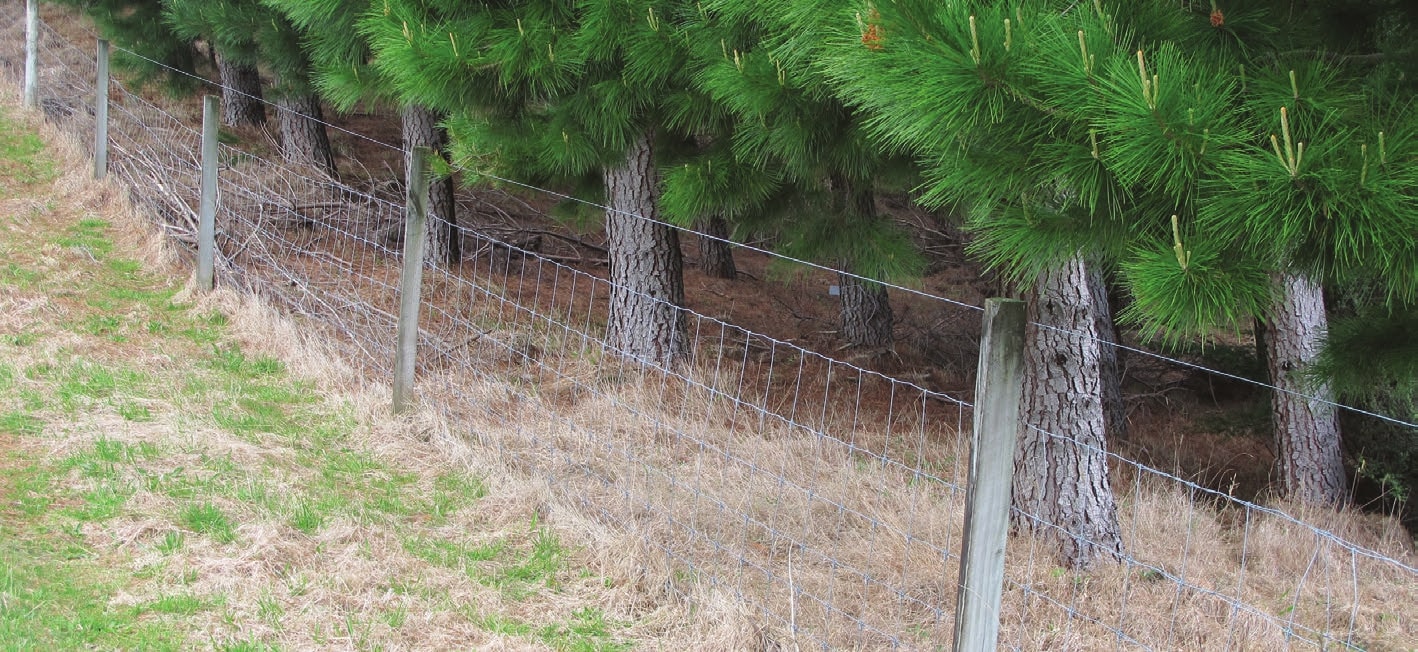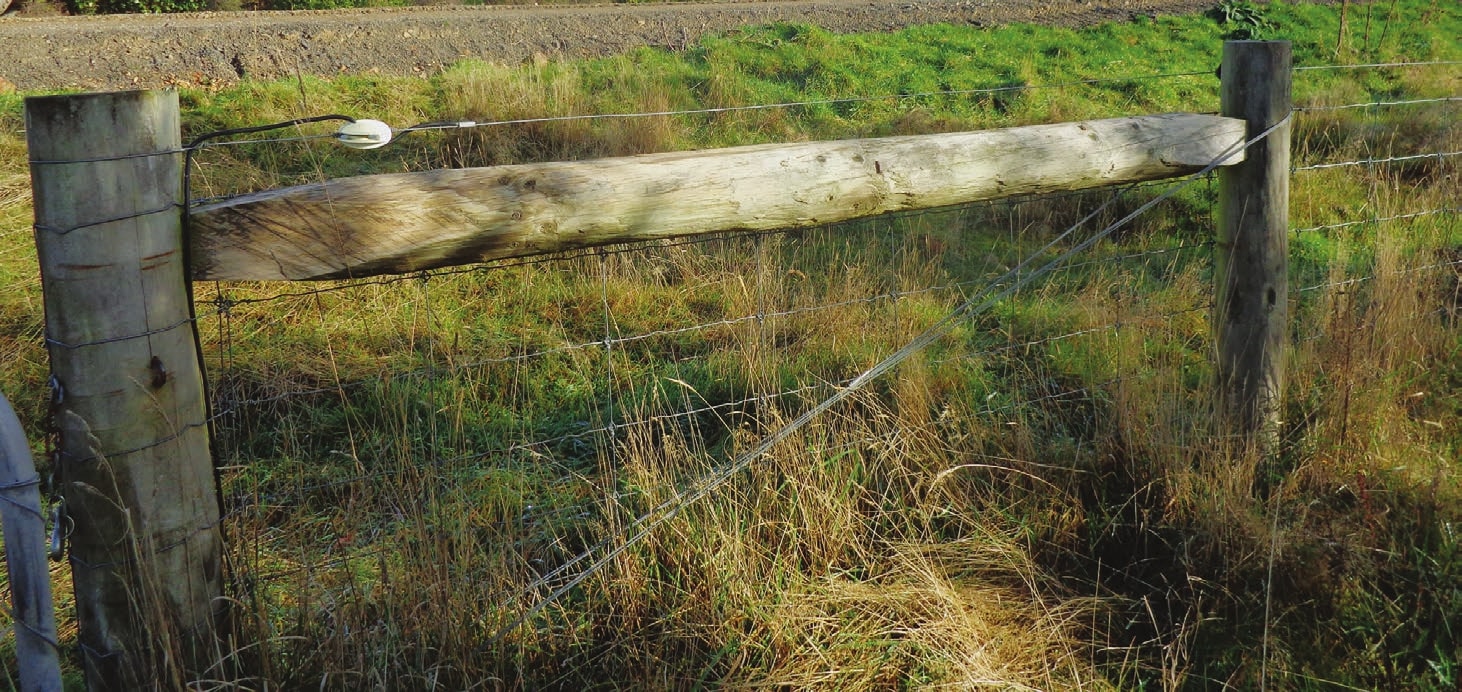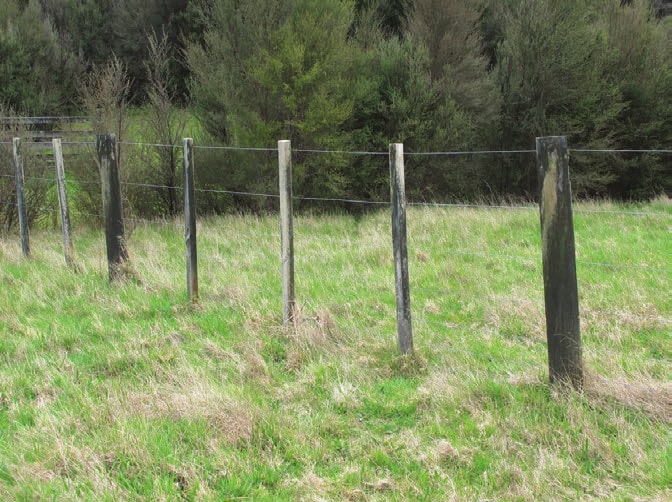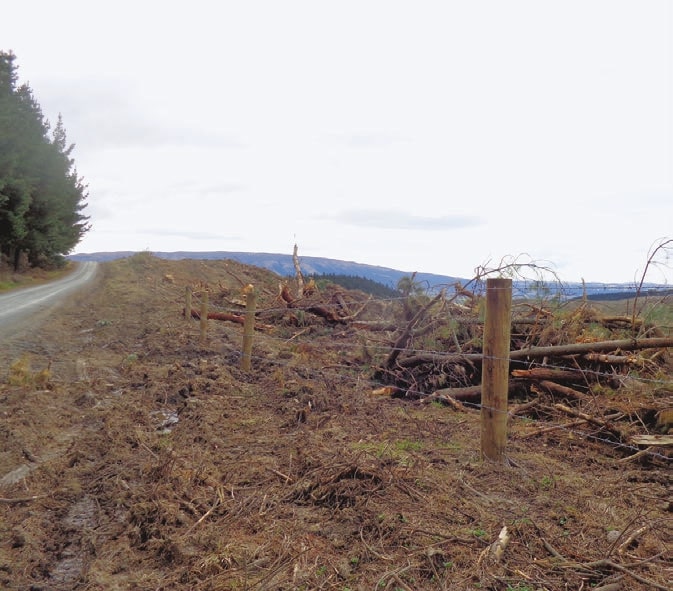What you might not know about forestry and fencing
Neil Cullen and Hamish Levack, New Zealand Tree Grower November 2016.
A quote noticed recently in the South Otago branch newsletter was by a founder and driving force of the branch, the late Vic Stephens. It stated that ‘the best fences on the farm should be around the tree blocks.’
Most farm foresters can probably understand the sentiment behind the statement above because protecting young trees, especially in their first decade, from marauding mammals is an essential part of forest establishment where land use is divided between grazing and forestry. When feed supplies are tight on a farm, hungry sheep cattle or deer are going to try their utmost to access the apparent free lunch they can see inside tree blocks, and a well-constructed and appropriate fence is a must.
However, fencing and forestry are not always happy partners. While the crop of trees is growing, the outside trees can blow down, and because of heavier branching on the open side they usually fall out over the fence requiring repairs and patch ups. When it comes to harvesting the forest, access for heavy machinery and logging trucks will often require removal of considerable lengths of fencing which has to be resurrected to protect the next planting.
Sawmills, naturally enough, do not appreciate staples or sections of wire attached to logs when they pass through their bandsaws. Most logging crews are skilled at directing falling trees away from fences but where slope or access make this difficult it will pay to offer to remove the fence or understand if a tree rolls on it. As we found recently, post harvest root raking can also result in fence damage as dislodged root balls can become unguided bouncing wrecking balls.
The right fence
So what is the best sort of fence to put around your precious trees? Most farmers are well aware of the various options, the costs and how to go about putting up a fence. But many NZFFA members do not come from a farming background and may find they have to erect fences to keep out stock.
First, you have to decide what type of animals you are going to keep out or in with your fence and how long you want the fence to last. In some cases, a fence may be only required until the trees are large enough to withstand grazing, which with radiata pine may be only six or seven years. In that situation cheaper or more temporary options may be used, but in most cases it would pay to erect a fence that will last the length of the rotation. A well constructed and maintained fence will easily remain effective for 40 or more years.
If you want to keep out sheep and cattle, my choice of fence would be would be treated posts four to five metres apart with 90 cm high netting and a separate high tensile wire above and below with the top wire electrified. The netting and wires must be strained tight using wire strainers, straining boards or permanent wire strainers fixed to the fence.
To be able to hold and maintain that tension you need to have constructed a sound strainer assembly at each end of the length of strain. To achieve this, which is the key to a successful fence, you need to dig or drive in a 2.4 metre strainer post. You then need to brace it using either an angled stay on to an underground block or a horizontal stay on to a solid post which is tied back to the bottom of the strainer. This latter method, usually known as a box stay, is most effective and shown in the photograph. A fence of this description using all new materials and erected by a contractor will cost in the region of $15 a metre.



Various options
There are many different options available. Steel standards, commonly known as waratahs, can be substituted for wooden posts. They are cheaper, easier to carry and bang in the ground, and do not burn, but they are generally not as strong as wood and can rust away quite quickly if you are near the coast.
North Islanders for some reason seem to prefer posts with eight or nine wires and battens attached every hammer length. As tree growers we should encourage using more of the material we grow, but battens are labour-intensive and can come loose with time. There is a long term problem with copper-chrome-arsenic treated posts which has been identified by vineyards and organic crop producers. One of the main problems is how to dispose of them when they break or come to the end of their useful life. However, until we adopt a more benign treatment method or grow enough naturally durable species to produce posts which do not need toxic chemical treatment, there are few viable alternatives.
If only cattle are to be kept out by the fence, then the options are much cheaper. Three barbed wires or two electric wires on posts 10 metres apart could be sufficient Electric wires are very effective as long as they are not shorted by long wet grass or tree foliage. If there is no electricity for a mains unit, there are reasonably priced solar powered electric fence units available.
If you are trying to keep rabbits or deer from your trees the fencing costs are going to increase. A South Otago farmer has successfully kept out wild deer from his newly planted native seedlings by topping up a sheep fence with two or three barbed wires. Costs can be greatly reduced by erecting the fence yourself especially if it is easy terrain with deep soils.
Contractors with their specialised equipment are probably the best option on steeper or rocky ground.
It will always pay to level the line before starting with a bulldozer or digger. New fencing materials and tools are readily available. PGG Wrightsons and Farmlands have stores nationwide and there are many other local options. They also have videos available on how to erect fences correctly.
It pays to shop around for the best prices especially for treated posts. Specialist farms such as Goldpine in the South Island often have special offers and there are many small mills and treatment plants which sell direct at lower prices. Second-hand materials can be purchased at farmer clearing sales and there is always TradeMe to check for bargains.

Taking offence about a fence?
Disputes between neighbours over the liability for the cost of a fence can make life unpleasant. An understanding of the law relating to these matters may help avoid potential problems. The Fencing Act 1978 provides a set of rules that govern financial obligations associated with a fence erected on a common boundary.
Responsibility for the costs
Normally you and your neighbour are obliged to share the costs of building or repairing a boundary fence. If you want to initiate this, the first step is to approach your neighbour to discuss what work you want to do and how much it will cost. If your neighbour is uncooperative a formal procedure must be followed before you can do any work on the boundary fence and claim a contribution from them.
You need to serve a written notice setting out the details of your proposal. If the fence is damaged or destroyed, which often happens on tree boundaries, the person responsible for the damage is liable to pay the full costs to repair the fence. If you cannot reach an agreement with your neighbour as to who is responsible to pay, the matter can be taken to either the Disputes Tribunal or the District Court depending on the amount involved.
A give-and-take boundary
A give-and-take boundary occurs when a give-and-take fence has been built over the legal boundary of an adjoining property because it was impracticable or undesirable to build a fence on the boundary. Usually, this will have been due to the nature of the topography, or the presence of a lake or stream.
If a forester plants trees over the legal boundary but inside the-give-and-take fence, the forester does not have automatic ownership of the trees. However, it may be possible to gain ownership of them by way of financial compensation, or better still, by way of a forestry right negotiated before the trees are established. Once you have begun to spend money on your crop your bargaining position will be weakened.
Wandering stock
Damage caused by straying stock from neighbouring land is covered by the term known as cattle trespass even if the damage is caused by sheep or goats. As with human trespass, cattle trespass applies where land is crossed without the consent of the owner. Under the rules of cattle trespass the owner of the livestock is liable for the damage caused by the stock straying on to another person’s land. However, it does not apply where stock stray on to a highway and then on to another person’s land which is covered by a different set of rules.
If your property or land is damaged due to cattle trespass you can either claim damages or impound the trespassing stock. There are special statutory procedures to follow when impounding stock. Do not dispose of the stock by selling them because legally, that would be theft and you could be prosecuted. Conversely, if you own the trespassing stock, you can refuse to pay damages if you can demonstrate that the claimant’s land was not adequately fenced.
There are other defences against a claim by your neighbour that your animals have been trespassing, such as that he consented to the stock entering the land, that the trespass was caused by the act of a stranger, or that your neighbour contributed to the trespass by his actions. Where you can establish a claim for cattle trespass the damages recoverable are those which are a natural consequence of the trespass such a damage to land and crops, chattels, and other stock. Yes, damage to young trees would be recoverable if cattle had eaten them or trampled on them.
Neil Cullen is a farmer in Southland and Hamish Levack a forest owner in the lower North Island. Both are members of the NZFFA executive, but these are their personal views.

 Farm Forestry New Zealand
Farm Forestry New Zealand